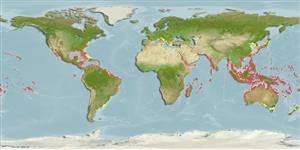Bryopsidophyceae |
Bryopsidales |
Halimedaceae
Environment: milieu / climate zone / গভীরতার পরিসীমা / distribution range
বাস্তুসংস্থান
; গভীরতার পরিসীমা 0 - 25 m (সূত্র 83908). Tropical
Indo-Pacific, Atlantic Ocean and the Mediterranean.
Length at first maturity / আকৃতি / Weight / Age
পরিপক্কতা : Lm ? range ? - ? cm
Thalli form greenish to cream amorphous clumps, attached by rhizoids at various points where segments get in contact with the substrate. Branches composed of moderately calcified flat segments with a distinct central rib, generally reniform to flabellate with the upper margin entire, sinuate to deeply lobed, 3 to 8 mm high, 4 to 10 mm wide, and 0.5 to 7 mm thick. Cortex consisting of 5 layers of utricles formed by repeated dichotomies from the medullary filaments; outermost utricles adhere slightly after decalcification, hexagonal in surface view, 23 by 40 to 50 μm in transverse section; secondary utricles about 17 μm wide. Central medullary filaments extend along the segments, terete and trichotomously branched, with evident constrictions at a short distance above the point of branching. Amorphous clumps up to 15 cm in diameter (Ref. 80758).
Not utilized commercially, although found to be a source of growth regulators such as auxin, gibberellin, cytokinin; has antibacterial and antifungal properties (Ref. 80758). Grows in the lower intertidal zone of coral reefs or on dead corals below the low-tide mark in calm shallow waters (Ref. 80758).
Life cycle and mating behavior
পরিপক্কতা | প্রজনন | ডিম ছাড়া | Eggs | ডিম্বধারন ক্ষমতা | Larvae
Guiry, M.D. and G.M. Guiry 2009 AlgaeBase. World-wide electronic publication, National University of Ireland, Galway. http://www.algaebase.org; searched on 14 April 2009. (সূত্র 80701)
IUCN Red List Status
(সূত্র 130435: Version 2025-1)
CITES status (সূত্র 108899)
Not Evaluated
Not Evaluated
Threat to humans
Human uses
| FishSource |
হাতিয়ার
আরো তথ্য
ট্রফিক বাস্তুতন্ত্র Food items (preys)
পথ্য উপাদান
খাদ্য গ্রহণ
শিকারী প্রাণী সমূহ
Population dynamicsবৃদ্ধিMax. ages / sizesLength-weight rel.Length-length rel.Length-frequenciesMass conversionপ্রাচুর্য Life cycleপ্রজনন
পরিপক্কতা
ডিম্বধারন ক্ষমতা
ডিম ছাড়া
Eggs
Egg development
Larvae
Physiologyঅম্লজান ব্যবহার
Human RelatedStamps, coins, misc.
ইন্টারনেট সুত্র
Estimates based on models
Preferred temperature
(Ref.
115969): 24.6 - 29.2, mean 28 (based on 4250 cells).
